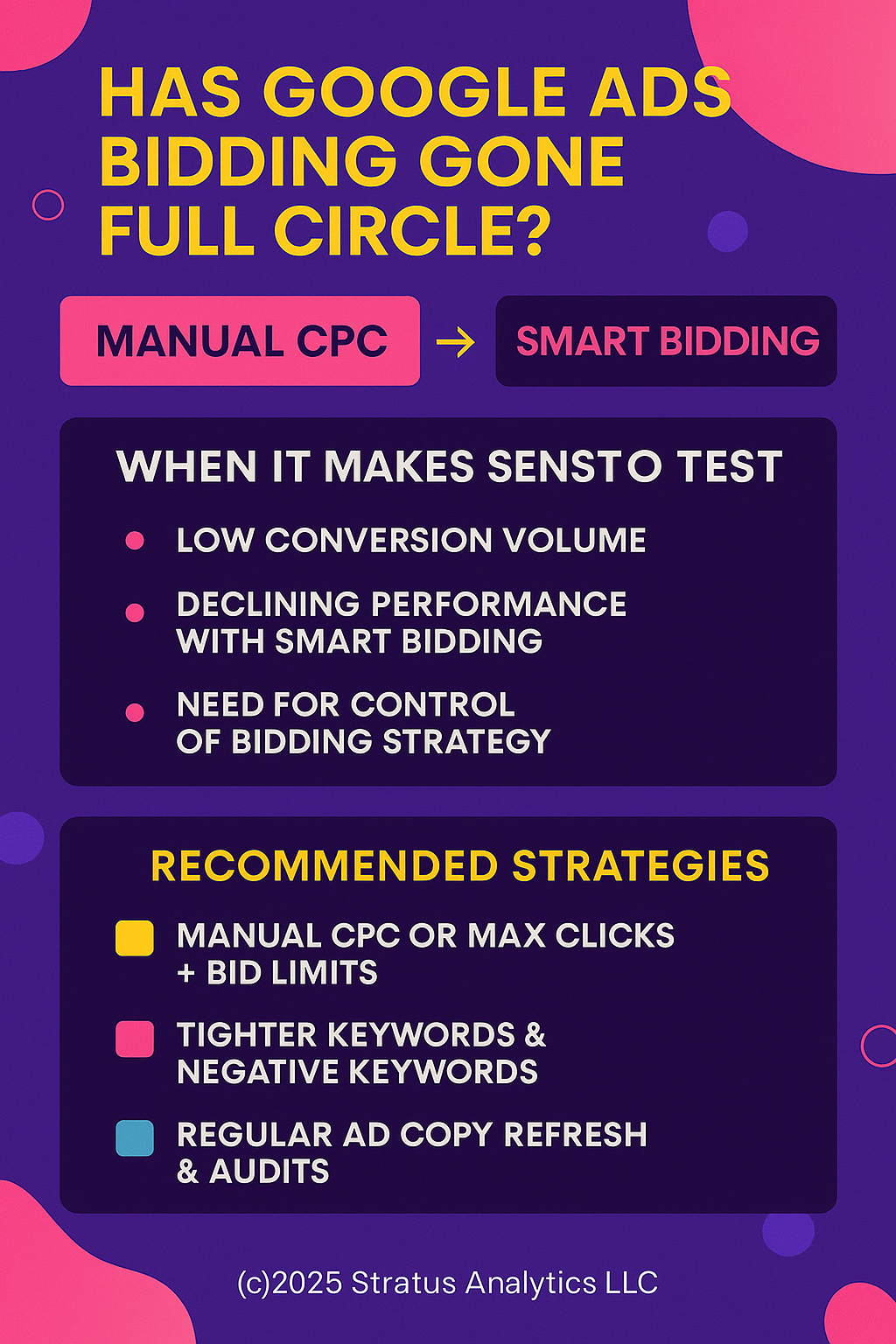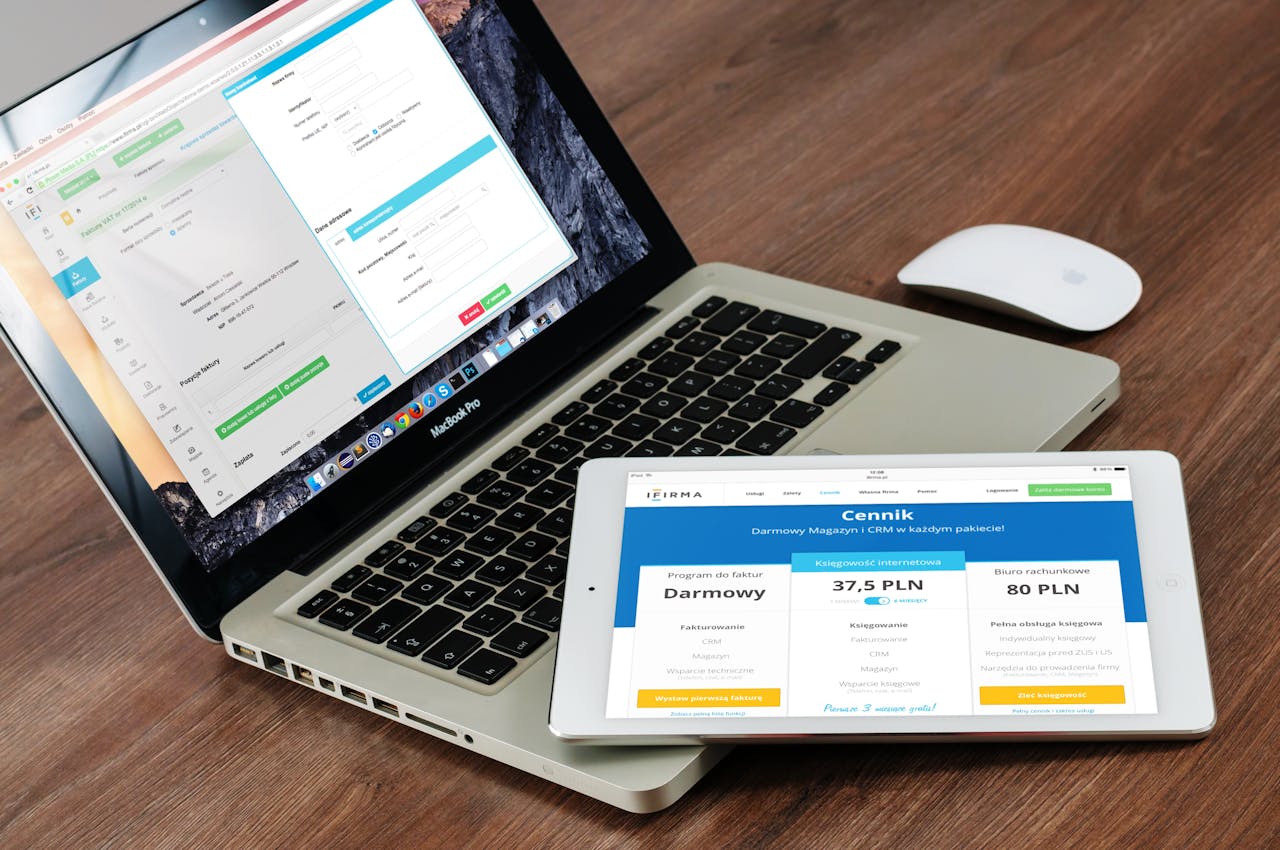Google Ads has been steadily nudging advertisers from manual CPC into Smart Bidding territory for years—with promises of automation, machine learning, and higher efficiency. And for many, those benefits are real. But here’s the twist:
Manual CPC is making a comeback.
In a recent campaign test, a brand running Smart Bidding (specifically Target ROAS) found that switching to Manual CPC resulted in:
- 42% more conversions
- 4x higher conversion value
- 30% lower cost per conversion
All while spending the same budget.
So what’s going on? Why is manual bidding—long considered old-school—suddenly competitive again? And how do you know which bidding strategy is right for your business?
Let’s unpack the data, the context, and the actionable guidance you can use today to get the most out of your Google Ads spend.

Smart Bidding: A Quick Refresher
Google’s Smart Bidding system uses machine learning to automatically adjust bids in real-time based on a wide array of contextual signals like device, location, time of day, and more. It includes strategies like:
- Maximize Conversions
- Maximize Conversion Value
- Target CPA (tCPA)
- Target ROAS (tROAS)
The idea is that automation handles complexity better than humans ever could. But here’s the catch: automation is only as smart as the data you feed it.
When Smart Bidding Breaks Down
In the example we’re analyzing, the advertiser had:
- Full-funnel conversion tracking integrated with Salesforce
- Revenue tied to leads via Offline Conversion Tracking (OCT)
- An ideal attribution setup on paper
And yet, over time, their Non-Brand campaigns:
- Saw CPCs rise slowly
- Qualified leads decline
- Conversion efficiency eroded, despite no major changes in the market or campaign setup
What they tried:
They tested manual CPC on an experiment campaign, keeping all other factors constant.
The result: Better performance across every metric.
So what gives?
3 Reasons Manual CPC May Outperform Smart Bidding (In Some Cases)
1. Insufficient Data Volume for Smart Bidding
Even if you meet Google’s stated thresholds (usually ~30 conversions/month for tCPA and ~50 for tROAS), Smart Bidding may still struggle with sparse data. If your campaign:
- Targets niche audiences
- Has longer buying cycles
- Uses custom CRM-based conversions (like SQLs or revenue events)
…then the algorithms might lack the scale needed to make optimal bidding decisions.
2. Inflated Bids in Competitive Markets
Smart Bidding has a tendency to over-bid in order to “win” auctions—especially when optimizing for value-based outcomes. If your conversion data has high variance or lags (common in B2B), the system may push bids too high, too fast.
Manual CPC, especially with tight bid caps, can impose discipline that Smart Bidding can’t.
3. Poor Signal Quality
If your conversion actions include:
- Low-quality MQLs
- Form fills without qualification
- Overly broad goals
…Google’s algorithm might “optimize” for the wrong outcomes. Manual bidding forces you to think critically about targeting, budget allocation, and keywords—rather than blindly trusting automation.
But Manual Bidding Isn’t a Silver Bullet
Before you switch everything back to Manual CPC, here’s a reality check:
- Manual bidding is labor-intensive
- It lacks real-time optimization
- You lose access to certain auction-time signals only available to Smart Bidding
In other words: manual CPC gives you control, but demands discipline.
So… When Should You Test Manual Bidding?
✅ Consider testing Manual CPC if:
- Your conversion volume is low or lumpy
- Your Smart Bidding results have declined over time
- Your cost/conversion is rising and efficiency is dropping
- You have strong insights into your best-performing keywords or match types
A Hybrid Strategy That Works: Max Clicks + Bid Limits
For advertisers who don’t want to go fully manual but still need control, Maximize Clicks + campaign-level bid limits is a smart middle ground.
This strategy:
- Gives Google the flexibility to optimize within guardrails
- Prevents out-of-control CPC spikes
- Is especially useful for top-of-funnel campaigns or when testing new markets
You’re still relying on automation—but without handing over a blank check.
How to Run a Manual CPC vs Smart Bidding Test (Step-by-Step)
Here’s how to run a controlled experiment inside Google Ads:
1. Set Up an A/B Experiment
Use Google Ads’ Experiments feature to clone your existing campaign, then:
- Keep targeting, budget, and creative identical
- Change only the bidding strategy
2. Choose Your Manual CPC Structure
Start with:
- Fixed CPCs for high-intent keywords
- Lower CPCs for broader queries
- Use negative keywords liberally to shape traffic quality
3. Monitor Key Metrics Closely
Track not just conversions, but:
- Cost per conversion
- Conversion value
- ROAS
- Qualified lead rate (using CRM/first-party data if possible)
4. Run the Test for at Least 4–6 Weeks
Give the campaigns time to gather statistically valid data. Look for consistent patterns, not just temporary fluctuations.
Pro Tips for Manual CPC Success
💡 Use Custom Columns
Track metrics that matter to you—like SQL rate, pipeline influenced, or revenue per lead.
💡 Tighten Up Match Types
Manual CPC thrives on precision. Use exact and phrase match to avoid junk traffic.
💡 Revisit Keyword Intent
Evaluate your keywords through a buyer intent lens. Not every click is worth bidding on.
💡 Refresh Ad Copy Frequently
Without Smart Bidding adjusting bids based on intent signals, your ads need to do more heavy lifting. Test headlines and CTAs weekly.
💡 Layer in Audience Exclusions
Remove job seekers, competitors, and irrelevant industries to avoid wasted spend.
What This Means for the Future of Google Ads
The truth is, we may be entering a “post-automation maturity” phase.
Smart Bidding isn’t going anywhere—but as more advertisers use it, the advantages of automation are leveling out. The competitive edge now lies in strategy, structure, and smarter testing.
Automation is a tool. Not a tactic. And certainly not a strategy.
Final Takeaway: Control > Convenience
For years, the prevailing wisdom has been: let the algorithm do its thing. But we’re now seeing that critical thinking still wins in PPC.
If your performance is plateauing, or worse—declining—don’t be afraid to revisit manual or hybrid bidding strategies. Sometimes, the best way forward is a little old school.
Summary of Actionable Bidding Options
| Scenario | Recommended Strategy |
|---|---|
| Low conversion volume | Manual CPC or Max Clicks + bid caps |
| Poor Smart Bidding performance | Test Manual CPC or tCPA instead of tROAS |
| Top-of-funnel awareness | Max Clicks with bid limits |
| Clear ROI targets and tight control | Manual CPC with regular audits |
| Large conversion volume, clean CRM data | Smart Bidding (tROAS or Max Conv. Value |

Hi there! I’m Scott, and I am the principal consultant and thought leader behind Stratus Analytics. I have a Master of Science degree in marketing analytics, and I’ve have been providing freelance digital marketing services for over 20 years. Additionally, I have written several books on marketing which you can find here on Amazon or this website.
DISCLAIMER: Due to my work in the packaging industry, I cannot take on freelance clients within the packaging manufacturing space. I do not want to provide disservice to your vision or my employer. Thank you for understanding.
